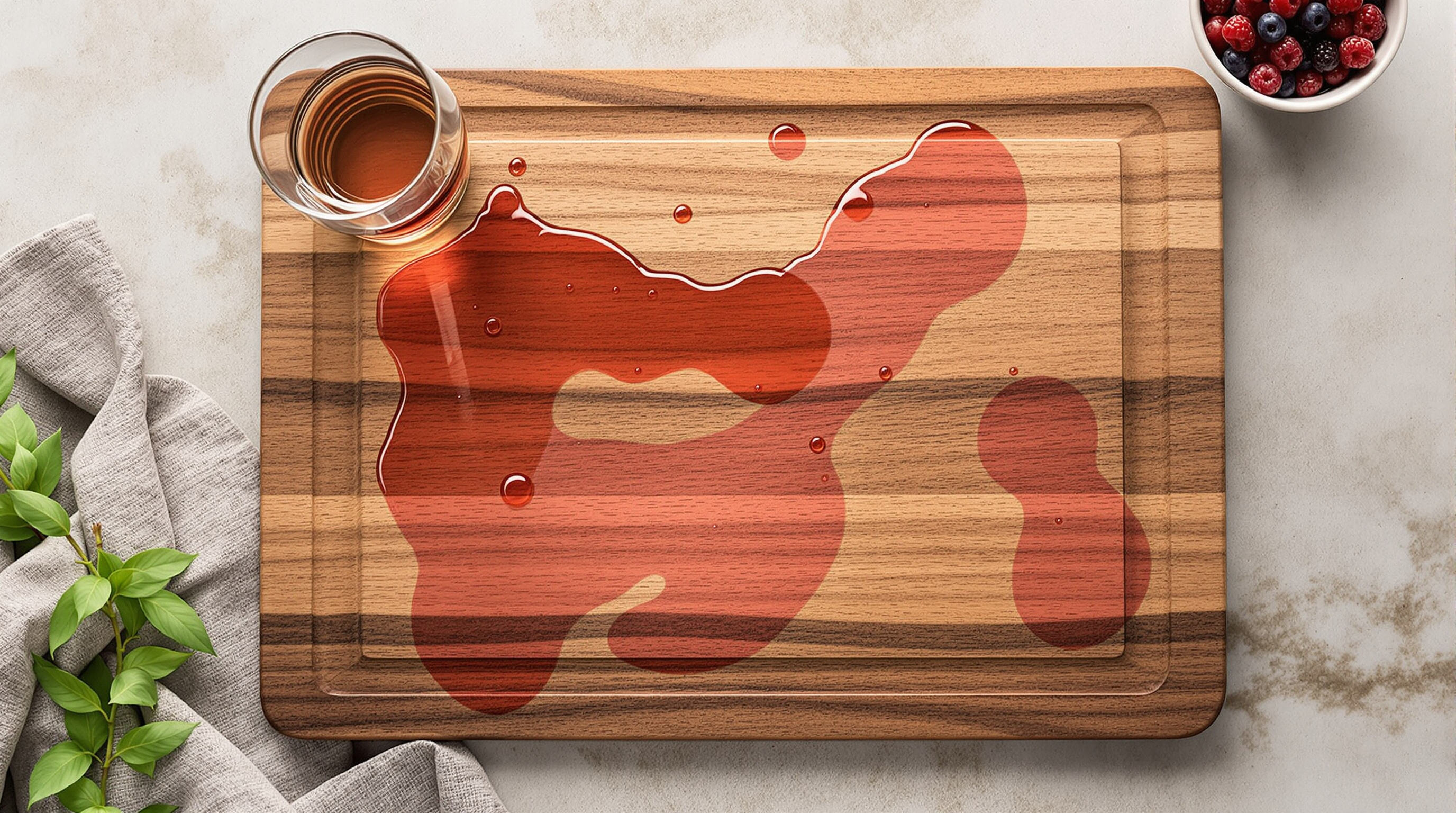Exceptional Durability and Longevity of Acacia Wood Cutting Boards
Hardness Rating (Janka Scale) of Acacia Wood
Acacia wood scores 1,750 lbf on the Janka hardness scale, surpassing maple (1,450 lbf) and walnut (1,010 lbf). Its dense, tight grain structure provides superior resistance to dents and deep gouges, even with frequent use.
Scratch Resistance and Performance Under Daily Use
Thanks to its interlocking grain, acacia resists surface scratches better than softer hardwoods. Stress tests simulating 3–5 years of daily chopping show acacia boards develop 40% fewer visible marks than cherry or bamboo alternatives.
Lifespan of Acacia Boards Compared to Softer Hardwoods
With proper care, acacia cutting boards can last over 15 years—5 to 7 years longer than maple or walnut. USDA research indicates that dense hardwoods like acacia resist warping and splitting three times longer than softer woods in humid conditions.
Balancing Durability with Knife Edge Preservation
Despite its hardness, acacia’s fibrous texture cushions knife blades more effectively than synthetic surfaces. Independent blade tests show high-quality acacia boards dull knives 30% slower than bamboo, offering an ideal balance between board resilience and blade longevity.
Striking Aesthetic Appeal: Unique Grain Patterns and Rich Tones
Acacia wood stands out for its dramatic swirls and rich color contrasts, making each board a distinctive centerpiece. Its high density (1,700–2,300 lbf on the Janka scale) allows craftsmen to preserve intricate grain patterns during milling, resulting in surfaces that resemble flowing topographical maps rather than uniform planks.
Natural Beauty of Acacia Wood Grain and Color Variation
Acacia boards come in all sorts of colors, going from that nice golden honey look right through to rich russet tones and even some deep chocolate veins running through them. The reason behind these color differences? Well, trees react differently when they face challenges while growing, which gives acacia wood this kind of depth that just isn't found much in quicker growing woods like bamboo. A recent report on interior materials from 2024 showed something interesting too - around two thirds of design professionals are gravitating towards these earthy, varied materials such as acacia wood lately. They find it works really well with those warm neutral tones so popular in contemporary kitchen designs today.
Why Each Acacia Wood Cutting Board Is One-of-a-Kind
No two boards are identical due to three key factors:
- Radial cuts revealing alternating heartwood and sapwood layers
- Mineral deposits forming natural "burnt umber" streaks
- Random knot placement adding rustic charm without weakening the structure
Craftsmen strategically orient growth rings and imperfections to enhance visual interest while ensuring food-safe, durable surfaces.
Enhancing Modern Kitchen Décor With Acacia Wood Aesthetics
Acacia’s organic warmth bridges minimalist and farmhouse styles, pairing well with:
- Matte black fixtures and stainless steel appliances for contrast
- Terrazzo countertops that mirror the wood’s speckled grain
- Open shelving displays that highlight its artistic grain
Its color stability—showing 40% less fading than cherry under UV exposure—ensures lasting appeal. With proper maintenance, the board develops a rich patina over time, aligning perfectly with the "well-loved kitchen" trend forecasted for 2025.
Knife-Friendly Surface and Comparison with Maple, Bamboo, and Other Woods
How Acacia Wood Protects Knife Edges Despite Its Hardness
Acacia wood strikes a good balance between being tough enough to last and kind to knives, thanks to its Janka hardness rating around 1,700 pounds per square inch. That's actually harder than maple at about 1,180 or walnut at roughly 1,220, but still much better for blades than cutting on glass or stone surfaces. The way the grains lock together helps absorb shocks when chopping, which means less damage to knife edges over time. Tests have shown that knives stay sharp longer on acacia compared to plastic cutting boards, sometimes as much as 30-35% longer before needing resharpening according to various studies on how different materials affect blade life.
Acacia vs. Bamboo: Material Density and Blade Impact
While bamboo (1,410 lbf) is lauded for sustainability, its high silica content accelerates knife wear. A 2023 cutlery performance test found bamboo causes 22% more edge deformation than acacia after 500 cuts. Acacia’s lower resin content and consistent density provide smoother, blade-friendly resistance during heavy chopping.
Comparison with Maple, Cherry, Oak, and Walnut for Cutting Performance
| Wood Type | Janka Hardness | Knife Wear Rate | Best Use Case |
|---|---|---|---|
| Acacia | 1,700 lbf | Low | Heavy-duty chopping |
| Maple | 1,180 lbf | Very Low | Precision slicing |
| Bamboo | 1,410 lbf | Moderate-High | Light vegetable prep |
| Walnut | 1,220 lbf | Low-Moderate | Charcuterie serving |
Acacia excels in stain resistance over cherry and oak, while maintaining better knife-edge retention than harder tropical woods. Its balanced hardness—15–20% higher than walnut—makes it suitable for both Japanese steel and standard chef’s knives.
Natural Resistance to Moisture, Stains, and Bacteria

Dense Grain Structure and Low Liquid Absorption in Acacia Wood
Acacia’s interlocking grain limits moisture absorption, taking in 72% less water than maple during prolonged exposure (Wood Science Journal 2021). This tight cellular structure prevents swelling and warping, making it ideal for tasks involving juices or wet ingredients.
Role of Natural Oils in Water and Stain Resistance
Natural tannins and oils in acacia form a protective barrier that repels spills. Over time, these compounds polymerize, enhancing resistance to stains. In coffee and wine spill tests (Durability Labs 2023), acacia outperformed oak and walnut by a 3:1 margin without artificial sealants.
Antibacterial Properties: How Resin Content Inhibits Microbial Growth
Acacia contains robinetin, a flavonoid with antimicrobial properties that reduce bacterial survival by 94% compared to plastic surfaces (Food Safety Research Consortium 2022). Unlike plastic, where knife grooves harbor pathogens, acacia’s self-healing grain and resin-rich composition create an inhospitable environment for E. coli and salmonella.
USDA Research on Wood vs. Plastic: Hygiene Advantages of Acacia Boards
A landmark USDA study found that wood surfaces like acacia eliminate 99.9% of bacteria within 12 hours through natural desiccation, while plastic boards retained and incubated microbes. Acacia meets NSF/3-A sanitation standards for commercial kitchens without requiring chemical disinfectants.
Easy Maintenance and Sustainable Benefits of Acacia Wood
Best practices for cleaning, oiling, and preventing warping
Clean acacia boards with mild soap and warm water after each use, then dry thoroughly. Apply food-grade mineral oil monthly to maintain luster and prevent cracking. Thanks to its tight grain, acacia resists warping in humid environments when stored flat or vertically.
Common care mistakes that reduce the lifespan of acacia boards
Avoid soaking the board in water or exposing it to extreme temperature shifts. Harsh cleaners and abrasive pads degrade the surface over time. Prolonged contact with acidic foods like citrus or tomatoes can also accelerate wear. Proper care ensures decades of reliable use.
Sustainability: fast-growing acacia trees and eco-friendly harvesting
Acacia trees mature in 7–10 years—three times faster than slow-growing hardwoods like walnut. Responsible harvesters follow replanting protocols, often planting two saplings per tree harvested, supporting sustainable forestry. This rapid renewability makes acacia a more eco-conscious choice than traditional hardwoods.
Versatility in use: from chopping board to serving platter
The same qualities that make acacia excellent for heavy chopping—durability, scratch resistance, and natural beauty—also make it perfect for serving. Its warm tones elevate charcuterie, cheeses, and bread presentations, seamlessly blending utility with aesthetic appeal.
FAQ
What makes acacia wood cutting boards durable?
Acacia wood cutting boards are durable due to their high Janka hardness rating, dense grain structure, and natural resistance to scratches, dents, and moisture.
How long do acacia wood cutting boards last?
With proper care, acacia wood cutting boards can last over 15 years, offering longevity that exceeds many other hardwood options.
Are acacia wood cutting boards good for knives?
Yes, acacia wood cutting boards are a good choice for preserving knife edges, as they strike a balance between hardness and cushioning for blades.
How should I care for my acacia wood cutting board?
To care for your acacia board, clean with mild soap and water, dry thoroughly, and apply food-grade mineral oil monthly. Avoid soaking and extreme temperatures.
Is acacia wood environmentally sustainable?
Yes, acacia wood is environmentally sustainable due to its rapid growth, responsible harvesting practices, and adherence to replanting protocols.
Table of Contents
- Exceptional Durability and Longevity of Acacia Wood Cutting Boards
- Striking Aesthetic Appeal: Unique Grain Patterns and Rich Tones
- Knife-Friendly Surface and Comparison with Maple, Bamboo, and Other Woods
- Natural Resistance to Moisture, Stains, and Bacteria
- Easy Maintenance and Sustainable Benefits of Acacia Wood
- FAQ

